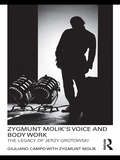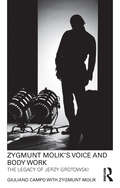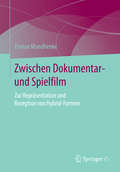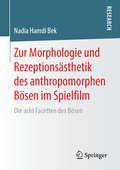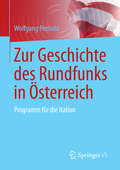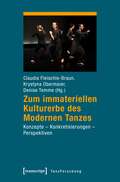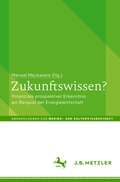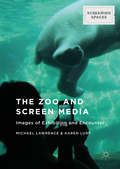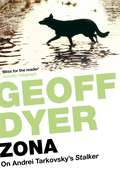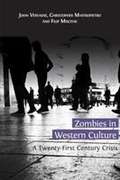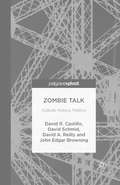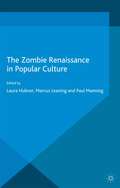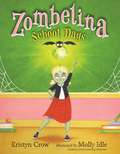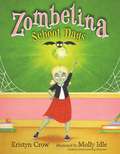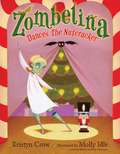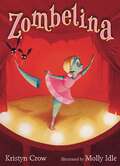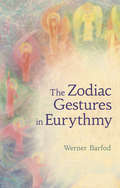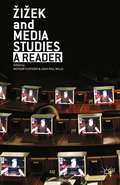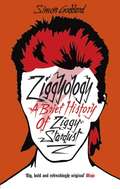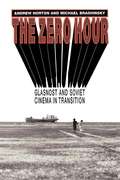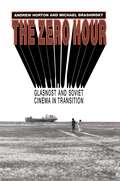- Table View
- List View
Zygmunt Molik's Voice and Body Work: The Legacy of Jerzy Grotowski
by Giuliano Campo Zygmunt MolikOne of the original members of Jerzy Grotowski’s acting company, Zygmunt Molik’s Voice and Body Work explores the unique development of voice and body exercises throughout his career in actor training. This book, constructed from conversations between Molik and author Giuliano Campo, provides a fascinating insight into the methodology of this practitioner and teacher, and focuses on his ‘Body Alphabet’ system for actors, allowing them to combine both voice and body in their preparatory process. The book is accompanied by a DVD containing the films Dyrygent (2006), which illustrates Molik’s working methods, Acting Therapy (1976), exploring his role in the Theatre of Participation, and Zygmunt Molik's Body Alphabet (2009). It also includes an extensive photo gallery documenting Zygmunt Molik’s life and work.
Zygmunt Molik's Voice and Body Work: The Legacy of Jerzy Grotowski
by Giuliano Campo Zygmunt MolikOne of the original members of Jerzy Grotowski’s acting company, Zygmunt Molik’s Voice and Body Work explores the unique development of voice and body exercises throughout his career in actor training. This book, constructed from conversations between Molik and author Giuliano Campo, provides a fascinating insight into the methodology of this practitioner and teacher, and focuses on his ‘Body Alphabet’ system for actors, allowing them to combine both voice and body in their preparatory process. The book is accompanied by a DVD containing the films Dyrygent (2006), which illustrates Molik’s working methods, Acting Therapy (1976), exploring his role in the Theatre of Participation, and Zygmunt Molik's Body Alphabet (2009). It also includes an extensive photo gallery documenting Zygmunt Molik’s life and work.
Zwischen Dokumentar- und Spielfilm: Zur Repräsentation und Rezeption von Hybrid-Formen
by Florian MundhenkeDer Band leistet eine umfassende Text- und Kontextanalyse der Herstellung, Gestaltung und Rezeption von Hybridformen von Gattungen mit dem Fokus auf Dokumentarfilm und Spielfilm. In drei Schritten erfolgt eine Annäherung an Mischformen von filmischen und fernsehspezifischen audiovisuellen Texten. Zunächst wird dabei die historische Entwicklungslinie von Formen anhand von Beispielen und mithilfe theoretischer Ausführungen expliziert. Im Anschluss werden sowohl eine inhaltliche und pragmatische Systematisierung der Formen sowie eine Einbettung in die Bereiche von Produktion, Text- und Diskursgestaltung sowie Rezeption geleistet. Zuletzt rundet eine empirische Studie zum Zuschauerverhalten und zur kontextuellen Einbettung dreier Beispiele die Ausführungen ab.
Zur Morphologie und Rezeptionsästhetik des anthropomorphen Bösen im Spielfilm: Die acht Facetten des Bösen
by Nadia Hamdi BekNadia Hamdi Bek befasst sich mit dem scheinbaren Paradox, dass amoralische Charaktere im Spielfilm auch positiv wirken und Faszination auslösen können. Im Fokus stehen dabei die Rekonstruktion der psychologischen Mechanismen bei ihrer Wahrnehmung und Beurteilung durch den Rezipienten sowie die Binnendifferenzierung ihrer Amoral. Im Gegensatz zu herkömmlichen Herangehensweisen zur Erforschung der Rezeptionsästhetik amoralischer Filmfiguren verbindet die Autorin geisteswissenschaftlich orientierte Theorien des Films und der Ästhetik mit der für die Psychologie typischen, dezidiert quantitativen, empirischen Forschungsmethodik.
Zur Geschichte des Rundfunks in Österreich: Programm für die Nation
by Wolfgang PensoldDas Buch bietet erstmals eine Gesamtschau auf die Geschichte des Österreichischen Rundfunks von den 1920er Jahren bis zur Gegenwart. Es schildert die Entstehung und Entwicklung des Radios ab 1924 und dessen Erweiterung um das Fernsehen ab 1955, und es spannt den Bogen bis zur jüngsten Erweiterung von Radio und Fernsehen um das Internet. Dabei integriert es unterschiedliche Gegenstandsfacetten – technische, politische, ökonomische, soziale und kulturelle – zu einer konsistenten Erzählung. Den roten Faden bildet dabei die Genese der öffentlichen Aufgabenstellung des Rundfunks.
Zum immateriellen Kulturerbe des Modernen Tanzes: Konzepte - Konkretisierungen - Perspektiven (TanzForschung)
by Claudia Fleischle-Braun Krystyna Obermaier Denise TemmeDer Moderne Tanz mit seinen pädagogisch-künstlerischen Konzepten (Chladek-System, Elementarer Tanz, Laban/Bartenieff-Bewegungsstudien und Jooss-Leeder-Methode) wurde 2014 von der Deutschen UNESCO-Kommission in die bundessweite Liste des Immateriellen Kulturerbes aufgenommen. Welche Bedeutung haben diese vier Ausprägungen des Modernen Tanzes im zeitgenössischen Tanzgeschehen und in der akademischen Tanz- und Tanzpädagogen-Ausbildung? Die Beiträger_innen des Bandes, darunter Vertreter_innen der vier Systeme als auch der Erziehungswissenschaft, Philosophie, Sportwissenschaft und Tanztherapie, untersuchen die künstlerisch-pädagogischen Konzepte in ihrer Vermittlungspraxis und gehen ihren Entwicklungen und Übersetzungen, Eigentümlichkeiten und Gemeinsamkeiten nach.
Zukunftswissen?: Potenziale prospektiver Erkenntnis am Beispiel der Energiewirtschaft (Abhandlungen zur Medien- und Kulturwissenschaft)
by Manuel MackasareVorstellungen von der Zukunft bestimmen das menschliche Handeln. In energiewirtschaftlichen Fragen sind solche Antizipationen besonders relevant: Staaten beschließen Förderprogramme, Unternehmen errichten Kraftwerke, Privatpersonen füllen ihre Öltanks oder ersetzen sie durch Wärmepumpen – stets mit Blick auf ein Morgen, der mitunter trügerisch ist. Kontrovers diskutiert wird, ob es ein Wissen von der Zukunft überhaupt geben und inwieweit es Gegenstand der Wissenschaft sein kann. Die Beiträge dieses Bandes untersuchen Möglichkeit, Methoden und Geltung von Zukunftsentwürfen aus philosophischer, historischer, sozial-, literatur- und medienwissenschaftlicher Perspektive.
The Zoo and Screen Media: Images of Exhibition and Encounter (Screening Spaces)
by Michael Lawrence Karen LuryThis book is the first critical anthology to examine the controversial history of the zoo by focusing on its close relationship with screen media histories and technologies. Individual chapters address the representation of zoological spaces in classical and contemporary Hollywood cinema, documentary and animation, amateur and avant-garde film, popular television and online media. The Zoo and Screen Media: Images of Exhibition and Encounter provides a new map of twentieth-century human-animal relations by exploring how the zoo, that modern apparatus for presenting living animals to human audiences, has itself been represented across a diverse range of moving image media.
Zona: A Book about a Film about a Journey to a Room
by Geoff DyerIn this spellbinding book, the man described by the Daily Telegraph as 'possibly the best living writer in Britain' takes on his biggest challenge yet: unlocking the film that has obsessed him all his adult life. Like the film Stalker itself, it confronts the most mysterious and enduring questions of life and how to live.
Zombies in Western Culture: A Twenty-First Century Crisis (PDF)
by John Vervaeke Christopher Mastropietro Filip MiscevicWhy has the zombie become such a pervasive figure in twenty-first-century popular culture? John Vervaeke, Christopher Mastropietro and Filip Miscevic seek to answer this question by arguing that particular aspects of the zombie, common to a variety of media forms, reflect a crisis in modern Western culture. The authors examine the essential features of the zombie, including mindlessness, ugliness and homelessness, and argue that these reflect the outlook of the contemporary West and its attendant zeitgeists of anxiety, alienation, disconnection and disenfranchisement. They trace the relationship between zombies and the theme of secular apocalypse, demonstrating that the zombie draws its power from being a perversion of the Christian mythos of death and resurrection. Symbolic of a lost Christian worldview, the zombie represents a world that can no longer explain itself, nor provide us with instructions for how to live within it. The concept of 'domicide' or the destruction of home is developed to describe the modern crisis of meaning that the zombie both represents and reflects. This is illustrated using case studies including the relocation of the Anishinaabe of the Grassy Narrows First Nation, and the upheaval of population displacement in the Hellenistic period. Finally, the authors invoke and reformulate symbols of the four horseman of the apocalypse as rhetorical analogues to frame those aspects of contemporary collapse that elucidate the horror of the zombie. Zombies in Western Culture: A Twenty-First Century Crisis is required reading for anyone interested in the phenomenon of zombies in contemporary culture. It will also be of interest to an interdisciplinary audience including students and scholars of culture studies, semiotics, philosophy, religious studies, eschatology, anthropology, Jungian studies, and sociology.
Zombies in Western Culture: A Twenty-First Century Crisis
by John Vervaeke Filip Miscevic Christopher MastropietroWhy has the zombie become such a pervasive figure in twenty-first-century popular culture? John Vervaeke, Christopher Mastropietro and Filip Miscevic seek to answer this question by arguing that particular aspects of the zombie, common to a variety of media forms, reflect a crisis in modern Western culture. The authors examine the essential features of the zombie, including mindlessness, ugliness and homelessness, and argue that these reflect the outlook of the contemporary West and its attendant zeitgeists of anxiety, alienation, disconnection and disenfranchisement. They trace the relationship between zombies and the theme of secular apocalypse, demonstrating that the zombie draws its power from being a perversion of the Christian mythos of death and resurrection. Symbolic of a lost Christian worldview, the zombie represents a world that can no longer explain itself, nor provide us with instructions for how to live within it. The concept of 'domicide' or the destruction of home is developed to describe the modern crisis of meaning that the zombie both represents and reflects. This is illustrated using case studies including the relocation of the Anishinaabe of the Grassy Narrows First Nation, and the upheaval of population displacement in the Hellenistic period. Finally, the authors invoke and reformulate symbols of the four horseman of the apocalypse as rhetorical analogues to frame those aspects of contemporary collapse that elucidate the horror of the zombie. Zombies in Western Culture: A Twenty-First Century Crisis is required reading for anyone interested in the phenomenon of zombies in contemporary culture. It will also be of interest to an interdisciplinary audience including students and scholars of culture studies, semiotics, philosophy, religious studies, eschatology, anthropology, Jungian studies, and sociology.
Zombie Talk: Culture, History, Politics
by John Edgar Browning David Schmid David Castillo David A. ReillyZombie Talk offers a concise, interdisciplinary introduction and deep analytical set of theoretical approaches to help readers understand the phenomenon of zombies in contemporary and modern culture. With essays that combine Humanities and Social Science methodologies, the authors examine the zombie through an array of cultural products from different periods and geographical locations: films ranging from White Zombie (1932) to the pioneering films of George Romero, television shows like AMC's The Walking Dead, to literary offerings such as Richard Matheson's I am Legend (1954) and Seth Grahame-Smith's Pride, Prejudice and Zombies (2009), among others.
The Zombie Renaissance in Popular Culture
by Paul Manning Laura Hubner Marcus LeaningThis collection addresses the significant cultural phenomenon of the 'zombie renaissance' – the growing importance of zombie texts and zombie cultural practices in popular culture. The chapters examine zombie culture across a range of media and practices including films games, music, social media, literature and fandom.
Zombelina School Days
by Kristyn Crow Molly IdleZombelina loves to dance, and going to school is just as fun! She leaps on the bus and twirls down the aisle. In class she raises her hand high in the air, even if sometimes it falls under her chair.When it's time for show-and-tell, Zombelina can't wait to share her hip-hop moves, but a new student named Morty has his own case of stage fright . . . something Zombelina knows how to fix. She has the perfect idea to make Morty feel welcome: a big rockin' dance party! After all, friends who dance together, stay together!
Zombelina School Days: School Days
by Kristyn Crow Molly IdleZombelina loves to dance, and going to school is just as fun! She leaps on the bus and twirls down the aisle. In class she raises her hand high in the air, even if sometimes it falls under her chair.When it's time for show-and-tell, Zombelina can't wait to share her hip-hop moves, but a new student named Morty has his own case of stage fright . . . something Zombelina knows how to fix. She has the perfect idea to make Morty feel welcome: a big rockin' dance party! After all, friends who dance together, stay together!
Zombelina Dances The Nutcracker
by Kristyn Crow Molly IdleIn another rhyming read-aloud tale full of delightful macabre humor Zombelina once again steals the show! This time Zombelina and her friend Lizzie are dancing in The Nutcracker. On the night of the big show, Zombelina is ready, but Grandpa Phantom has other plans for the opera house. Zombelina will need to think fast to save the show, and she'll need Lizzie's help. When best friends work together, the show will go on! Young dancers and readers will love this family-filled, friendship-inspired picture book that brings Zombelina home for the holidays in another scary-good story!
Zombelina Dances The Nutcracker
by Kristyn Crow Molly IdleIn another rhyming read-aloud tale full of delightful macabre humor Zombelina once again steals the show! This time Zombelina and her friend Lizzie are dancing in The Nutcracker. On the night of the big show, Zombelina is ready, but Grandpa Phantom has other plans for the opera house. Zombelina will need to think fast to save the show, and she'll need Lizzie's help. When best friends work together, the show will go on! Young dancers and readers will love this family-filled, friendship-inspired picture book that brings Zombelina home for the holidays in another scary-good story!
Zombelina
by Kristyn Crow Molly IdleZombelina loves to dance. She moonwalks with mummies and boogies with bats. She spins like a specter and glides like a ghost and loves to dance for her family the most. When Zombelina enrolls in a ballet class for real girls, her dancing gives everyone the chills! But when her first recital brings on a case of stage fright, her zombie moans and ghoulish groans scare her audience away. Only her devoted family's cheers, in their special spooky way, help Zombelina dance the ballet debut of her dreams. Introducing the most adorable zombie to ever grace the dance floor, Kristyn Crow's pitch-perfect rhyme and Molly Idle's charmingly spook-tacular illustrations will make every reader want to sway and sashay in their own zombie trance.
Zombelina: School Days
by Kristyn Crow Molly IdleZombelina loves to dance. She moonwalks with mummies and boogies with bats. She spins like a specter and glides like a ghost and loves to dance for her family the most. When Zombelina enrolls in a ballet class for real girls, her dancing gives everyone the chills! But when her first recital brings on a case of stage fright, her zombie moans and ghoulish groans scare her audience away. Only her devoted family's cheers, in their special spooky way, help Zombelina dance the ballet debut of her dreams. Introducing the most adorable zombie to ever grace the dance floor, Kristyn Crow's pitch-perfect rhyme and Molly Idle's charmingly spook-tacular illustrations will make every reader want to sway and sashay in their own zombie trance.
The Zodiac Gestures in Eurythmy
by Werner BarfodEurythmy is an art form that makes sounds visible. By incorporating zodiac gestures into their art, as indicated by Rudolf Steiner, eurythmists can draw on a deep connection between the earth and the cosmos. The zodiac, as representative of the whole cosmos, is a vital part of human spirituality, acting as the backdrop to human life. But it can be hard to fathom the zodiac's secrets, even through meditation. Barfod draws a parallel between meditative exercises and eurythmy practice, and shows how zodiac gestures in eurythmy can reveal cosmic insights. This is a book for eurythmy teachers and practitioners who want to deepen their art and spiritual work.
Zizek and Media Studies: A Reader
by Matthew Flisfeder Louis-Paul WillisFilm, media, and cultural theorists have long appealed to Lacanian theory in order to discern processes of subjectivization, representation, and ideological interpellation. Here, the contributors take up a Zizekian approach to studies of cinema and media, raising questions about power, ideology, sexual difference, and enjoyment.
Ziggyology: A Brief History Of Ziggy Stardust
by Simon GoddardHe came from Outer Space...It was the greatest invention in the history of pop music – the rock god who came from the stars – which struck a young David Bowie like a lightning bolt from the heavens. When Ziggy the glam alien messiah fell to Earth, he transformed Bowie from a prodigy to a superstar who changed the face of music forever. But who was Ziggy Stardust? And where did he really come from?In a work of supreme pop archaeology, Simon Goddard unearths every influence that brought Ziggy to life – from HG Wells to Holst, Kabuki to Kubrick, and Elvis to Iggy. Ziggyology documents the epic drama of the Starman’s short but eventful time on Planet Earth… and why Bowie eventually had to kill him.
The Zero Hour: Glasnost and Soviet Cinema in Transition
by Andrew Horton Michael BrashinskyNow faced with the "zero hour" created by a new freedom of expression and the dramatic breakup of the Soviet Union, Soviet cinema has recently become one of the most interesting in the world, aesthetically as well as politically. How have Soviet filmmakers responded to the challenges of glasnost? To answer this question, the American film scholar Andrew Horton and the Soviet critic Michael Brashinsky offer the first book-length study of the rapid changes in Soviet cinema that have been taking place since 1985. What emerges from their collaborative dialogue is not only a valuable work of film criticism but also a fascinating study of contemporary Soviet culture in general. Horton and Brashinsky examine a wide variety of films from BOMZH (initials standing for homeless drifter) through Taxi Blues and the glasnost blockbuster Little Vera to the Latvian documentary Is It Easy to Be Young? and the "new wave" productions of the "Wild Kazakh boys." The authors argue that the medium that once served the Party became a major catalyst for the deconstruction of socialism, especially through documentary filmmaking. Special attention is paid to how filmmakers from 1985 through 1990 represent the newly "discovered" past of the pre-glasnost era and how they depict troubled youth and conflicts over the role of women in society. The book also emphasizes the evolving uses of comedy and satire and the incorporation of "genre film" techniques into a new popular cinema. An intriguing discussion of films of Georgia, Estonia, Latvia, Lithuania, and Kazakhstan ends the work.
The Zero Hour: Glasnost and Soviet Cinema in Transition
by Andrew Horton Michael BrashinskyNow faced with the "zero hour" created by a new freedom of expression and the dramatic breakup of the Soviet Union, Soviet cinema has recently become one of the most interesting in the world, aesthetically as well as politically. How have Soviet filmmakers responded to the challenges of glasnost? To answer this question, the American film scholar Andrew Horton and the Soviet critic Michael Brashinsky offer the first book-length study of the rapid changes in Soviet cinema that have been taking place since 1985. What emerges from their collaborative dialogue is not only a valuable work of film criticism but also a fascinating study of contemporary Soviet culture in general. Horton and Brashinsky examine a wide variety of films from BOMZH (initials standing for homeless drifter) through Taxi Blues and the glasnost blockbuster Little Vera to the Latvian documentary Is It Easy to Be Young? and the "new wave" productions of the "Wild Kazakh boys." The authors argue that the medium that once served the Party became a major catalyst for the deconstruction of socialism, especially through documentary filmmaking. Special attention is paid to how filmmakers from 1985 through 1990 represent the newly "discovered" past of the pre-glasnost era and how they depict troubled youth and conflicts over the role of women in society. The book also emphasizes the evolving uses of comedy and satire and the incorporation of "genre film" techniques into a new popular cinema. An intriguing discussion of films of Georgia, Estonia, Latvia, Lithuania, and Kazakhstan ends the work.
The Zero Hour: Glasnost and Soviet Cinema in Transition
by Andrew Horton Michael BrashinskyNow faced with the "zero hour" created by a new freedom of expression and the dramatic breakup of the Soviet Union, Soviet cinema has recently become one of the most interesting in the world, aesthetically as well as politically. How have Soviet filmmakers responded to the challenges of glasnost? To answer this question, the American film scholar Andrew Horton and the Soviet critic Michael Brashinsky offer the first book-length study of the rapid changes in Soviet cinema that have been taking place since 1985. What emerges from their collaborative dialogue is not only a valuable work of film criticism but also a fascinating study of contemporary Soviet culture in general. Horton and Brashinsky examine a wide variety of films from BOMZH (initials standing for homeless drifter) through Taxi Blues and the glasnost blockbuster Little Vera to the Latvian documentary Is It Easy to Be Young? and the "new wave" productions of the "Wild Kazakh boys." The authors argue that the medium that once served the Party became a major catalyst for the deconstruction of socialism, especially through documentary filmmaking. Special attention is paid to how filmmakers from 1985 through 1990 represent the newly "discovered" past of the pre-glasnost era and how they depict troubled youth and conflicts over the role of women in society. The book also emphasizes the evolving uses of comedy and satire and the incorporation of "genre film" techniques into a new popular cinema. An intriguing discussion of films of Georgia, Estonia, Latvia, Lithuania, and Kazakhstan ends the work.
